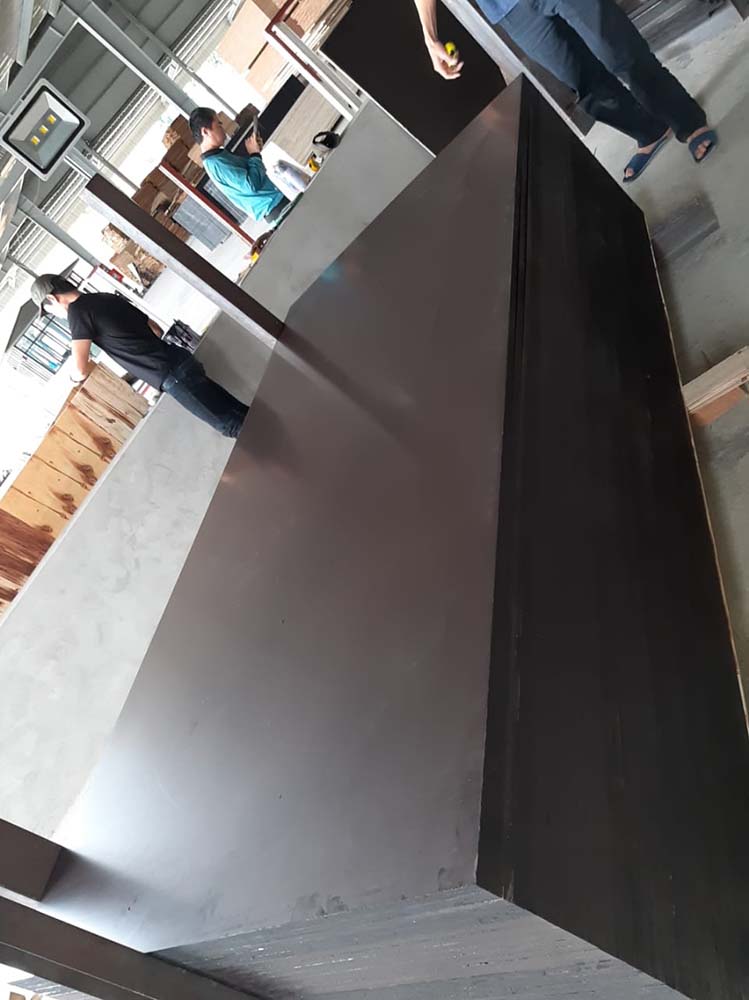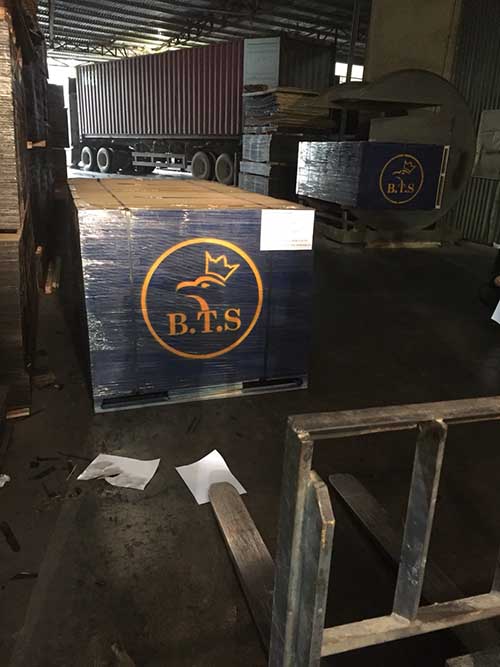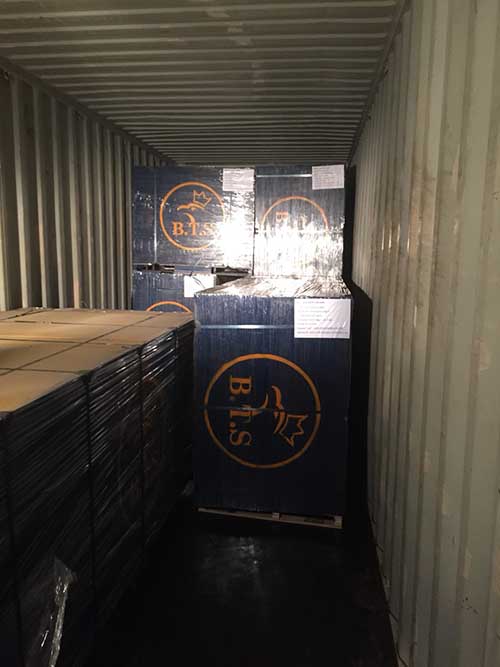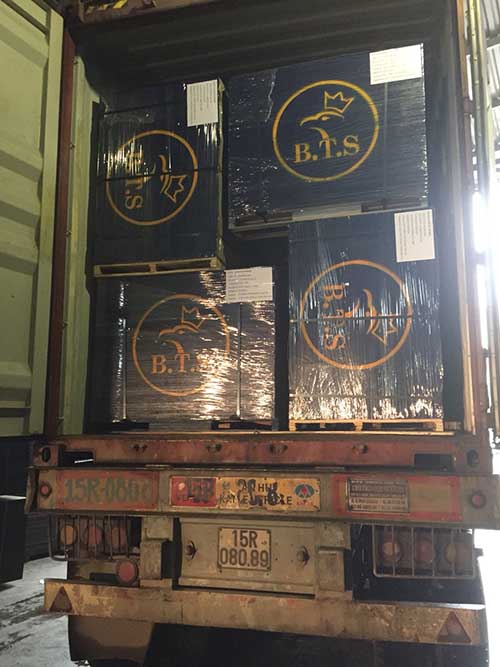Film faced plywood
Film faced plywood is a very popular construction material due to its versatility and efficiency. Kim Global is a manufacturer and distributor of Film faced plywood in the Vietnam and we are exporting Film faced plywood to many areas.
Table of contents
1. Specification of Film faced plywood

|
FILM FACED PLYWOOD |
|
|
Core |
Acacia wood, eucalyptus and others |
| Film |
Brown or black |
| Size |
1220mmx2440mm or as demand |
| Glue |
Melamin, ure formanldehyde( E1, E2), phenol formanldehyde |
| Thickness |
12mm, 15mm, 17mm, 18mm or as demand |
| Actual difference |
+/- 0.5 mm |
| Number of layers |
7-11 layers |
| Moisture |
<15% |
|
Minimum order |
1 cont 20ft hoặc 40ft |
| Usage | Construction |
| Package |
Pallets, stable |
2. How to produce Film faced plywood by Kim Global
The beginning: preparation of raw materials
The manufacturing process of film faced birch plywood requires the careful selection and preparation of raw materials. First, timber of the right size are selected. For the production of standard-sized plywood in Russia (1220mmx2440mm), timber with a diameter of 20-40 cm and a length of 5.2 m are used (later on, these timber can be cut into logs with a length of 1.3m or 2.6m, which are needed for the production of long grain and cross grain veneer sheets of the required size).
The main stage of preparation is to soak the raw materials. This is done in a special pool (which is open or covered) for 24 hours. In summer, the temperature inside the pool is kept at 35-40оC and in winter at 40-45оC. To improve the quality of the veneer from which the plywood will be made, it is important at this stage to maintain the temperature at the right level and condition the wood for the right amount of time.
The softened logs are then transferred to the debarking and cutting department.
Debarking is done in the following way: the special knives of the debarking machine make a cut in the bark and remove it in a spiral-like fashion. The removed bark is used for heating not only the plant itself but also the adjacent buildings and even the whole village. This is the procedure, for example, at the Perm Plywood Mill (SVEZA Group). The boiler house serves the whole mill and the village Uralsky, in which the mill is located.
The debarked logs (almost without bark) are then passed through a metal detector. This helps to detect metallic impurities in the wood, such as nails, bits of wire etc., which could damage the equipment. When metal is detected, a signal is sent to the control panel of the machine, the conveyer is stopped, and the metal is removed by the operator.
After debarking, the wood is cut up. The processed raw materials are sawn into logs for the production of long grain and cross grain veneer sheets.
The production and processing of veneer
The next step is to peel the veneer on special machines, where a thin, continuous strip of veneer is peeled off the prepared log. The thinner the veneer, the more layers the plywood of certain thickness will have. The more layers – the stronger the plywood. Russian birch veneer is the thinnest (1.2-1.5 mm) compared to other wood species (such as poplar veneer, which is 1.6-2.6 mm thick, and pine veneer, which is 2-4 mm thick).
At the peeling stage, quality control of the veneer is carried out: samples are taken daily to check its thickness and a number of other factors, and the results are compared to the standard. The settings of the peeling machines are then adjusted based on these results.
AAfter the peeling, automatic clippers cut the veneer strip into 1.3m x2.6m sheets for the production of 1220×2440 mm plywood. Long grain and cross grain veneer (for subsequent adhesion into a single sheet of plywood) is made on separate peeling lines.
The cut up veneer sheets are then dried.
“In the dryer, hot air is blown on the veneer sheets. Within 8-10 minutes, up to 90% of the moisture is eliminated from the wood. After drying, the veneer sheets are stacked onto a pallet or a conveyor belt (depending on the design of the dryer),“ says Natalia Andreeva, a film faced plywood manufacturing Typeer at the Fanplit Plywood Mill, which belongs to the SVEZA group.
After drying, the veneer is graded by a variety of properties, including the presence of knot-holes, cracks, etc. Many mills use automated equipment at this stage: the properties of each grade are programmed into a computer, which controls the process. During the grading, the surface is scanned and automatically evaluated, after which the scanner divides the veneer into different stacks. In this case, the operator just oversees the process. At this stage, the moisture level of the sheets is also assessed. If the veneer is not sufficiently dry, it is placed in a separate stack and fully dried later.
If defects are found during the grading stage, the sheets are not utilized and sent for repair instead. Veneer repairs can be performed on machines that are manually -operated, as well as on automated ones. The automated machines can improve the quality of the plywood, reducing expenses on manual labor 3-fold. Nowadays, equipment exists to repair veneer any size: standard – 5×5 feet (1525×1525 mm), and large – 5×10 feet (1500/1525×3000/3050 mm). After repair, the veneer is graded once again.
Plywood assembly
To obtain a finished piece of plywood, several sheets of veneer must be glued together. The fibers in each layer of veneer are perpendicular to each other, which gives strength to the finished product. The finished sheets are resistant to any kind of deformation. This property makes plywood an ideal material for formwork systems in concrete construction.
In the production of birch plywood, an odd number of veneer sheets are glued together into a piece of plywood 3 to 40 mm thick. The sheets are glued together using an adhesive that is also produced here, in a special mixer. It consists of chalk, water, resin, and wood or rye flour. Strict adherence to the production guidelines of the adhesive is crucial in order prevent the layers of plywood from ungluing. Modern mills have equipment that automatically adjusts the proportions of the adhesive’s ingredients in line with the formulation of the solution.
In the next step – rolling – the veneer sheets are pressed between two rollers, and smeared with the adhesive. The adhesive is evenly distributed across both sides of the sheets, after which the sheets are sent for pressing.
“Dry veneer alternates with veneer that is coated with adhesive. The number of sheets depends on the thickness of the plywood. At the end of the assembly process of one sheet of plywood, the machine feeds two dry veneer sheets (the last sheet for the previous “sandwich“ and the first sheet for the next), which will later enable one sheet of plywood to be separated from another. After this, the prepared stack is sent for pre-pressing,“ says Elena Vershinina, quality control manager at the Perm Plywood Mill, which belongs to the SVEZA group.
Cold pre-pressing of glued veneer sheets is done just before the hot-pressing in order to obtain quality bundles that are easy to transport and load into a hot press. The cold pre-pressing takes about 5-10 minutes at a pressure of 1-1.5 MPa.
After that, the glued sheets are loaded onto a hot press rack for final adhesion at a temperature of 120-130°C, at a pressure of 1.2-1.8 MPa.
After pressing, the glued sheets are trimmed on all four sides into the size requested by the customer: for example, 1250×2500 mm or 1220×2440 mm, with a precision up to 3 mm. In the production of film faced plywood, the machine performs a preliminary trim to 1290×2550 mm, so that after applying the film, the sheet can be trimmed again, taking off the remaining millimeters.
After that, the plywood is sanded on a machine to give it a smooth surface and an even thickness. After that, the plywood is fed through sanding belts with different grain sizes. After that, the plywood is once again classified according to its appearance: the operator assesses the quality of the sheets.
The final stage: laminating the surface
In the final stage, a film is applied to both sides of the plywood sheets. Then the plywood is loaded onto a multi opening press, which can simultaneously hold 15-18 sheets. Pressing, where the film bonds with the surface of the sheet, takes 4.5-10 minutes at a temperature of 130-136оC. The pressing time depends on the density of the film, the thickness of the plywood, and the type of finish (smooth or wire mesh). The film gives the plywood additional protection from water and mechanical damage, and from corrosive environments. In this way, the ordinary “white“ plywood becomes coated or film faced plywood.
In addition to the glossy film, a wire mesh coating can be applied to film faced plywood, which has an anti-slip effect. This kind of plywood is in demand in the transport Typeering industry: it is used in the floors of trailers and light commercial vehicles. It is also used for flooring in scaffolding on construction sites.
Next, the film faced plywood is sent to the cutting line, where it is cut to the designated size.
After that, the finished product is sorted according to its appearance and geometric parameters, and packaged. After the sorting is finished, the bundles of plywood are delivered to the paint-spraying booth. Here, a special latex paint with an acrylic base is applied to the ends of the sheets. This coating protects the plywood from moisture and expansion.
The better the ends are painted, the more water-resistant the sheets will be, and thus the plywood will be able to withstand more concrete pouring cycles. This is especially important for slab formwork, where the plywood is exposed to high mechanical loads and corrosive environments, i.e. concrete mix.
If the film faced plywood is glued together well, has a smooth surface covered with wear-resistant coating, and its ends are protected from moisture, it will retain its shape for a longer period. This means that, even with repeated use of the same sheet of plywood (at least 15-20 cycles) the quality of the concrete slabs will be unchanged.
3. Film faced plywood images











